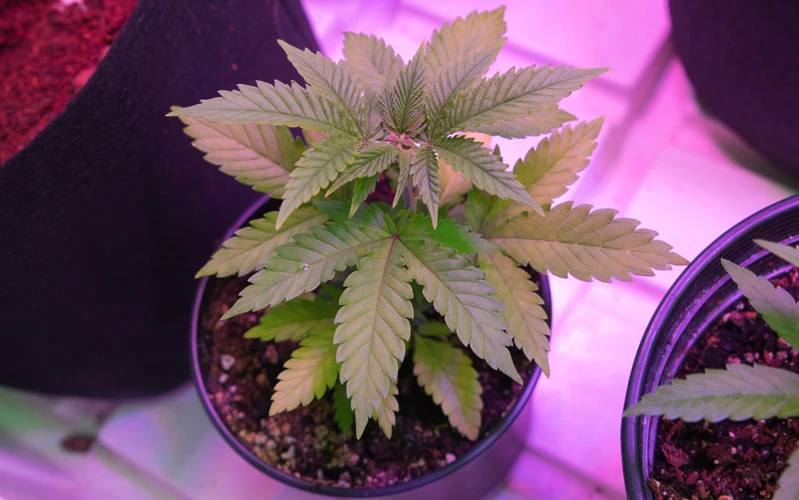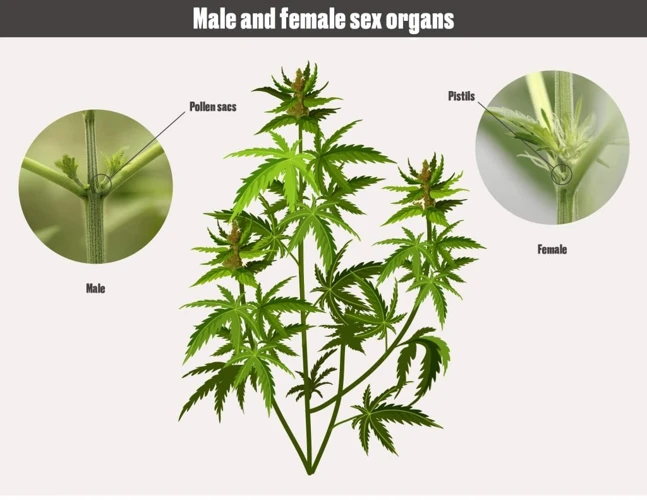
Tips for Breeding Your Own Disease-Resistant Cannabis Strains
For cannabis growers, breeding disease-resistant strains can be a perplexing challenge. With so many potential diseases to guard against, it can be difficult to know where to start. However, by understanding the common diseases that affect cannabis, selecting the right parent plants, and implementing effective breeding techniques, it is possible to create new strains that are resistant to these threats. In this article, we’ll explore the step-by-step tips for breeding disease-resistant cannabis strains to help you stay ahead of the game and produce robust and healthy plants.
Understanding Cannabis Diseases
Contents
As a cannabis breeder, understanding the potential diseases that can affect your plants is crucial for producing healthy and high-quality strains. Diseases can cause stunted growth, decreased yields, and even the death of your plants. It’s important to have a strong grasp on the characteristics of common cannabis diseases and how they can spread, to not only prevent them but also to selectively breed for disease resistance. With that in mind, let’s take a closer look at the various types of cannabis diseases and how they can impact your plants.
Identifying Common Cannabis Diseases
One of the first steps towards breeding disease-resistant cannabis strains is understanding the common diseases that can affect these plants. Identifying these diseases early on is crucial in preventing an outbreak from harming your crop. Here are some of the most common cannabis diseases to keep an eye out for:
- Gray Mold: Also known as Botrytis cinerea, this is a fungal disease that can spread quickly and cause significant damage to cannabis flowers. Gray mold typically appears as gray or brown spots on the surface of the plant, and can cause plants to rot from the inside out.
- Mildew: Powdery mildew is another fungal disease that cannabis growers need to watch out for. It appears as white or gray spots on the leaves, stems, and flowers of the plant. If left untreated, it can cause reduced plant growth and yield.
- Bud Rot: Also known as botrytis bud rot, this disease is caused by the fungus Botrytis cinerea. It typically affects the plant’s buds and flowers, causing them to become moldy and discolored. This can lead to the reduction in the potency and quality of the final product.
- Root Rot: This disease is caused by various fungi and can be difficult to detect. Initial symptoms of root rot include slow plant growth, yellowing leaves, and wilted plants. If not treated, it can result in the plant’s death.
- Virus: Cannabis plants can also be affected by viral diseases, which can cause a range of symptoms. Yellowing leaves, stunted growth, and leaf curling are some of the common signs of a viral infection in cannabis plants.
By learning to recognize these diseases before they spread, you can take the necessary steps to control and prevent them from affecting your cannabis plants.
How Cannabis Diseases Spread
Cannabis diseases can spread in various ways, which is why proper precautions should be taken to prevent them from infecting your plants. Below we have listed some of the common methods through which cannabis diseases can spread:
| Method | Description |
|---|---|
| Insects and pests | Insects and pests, such as spider mites, whiteflies, and thrips, are common carriers of cannabis diseases. They transfer the diseases from one plant to another as they move from one location to another. |
| Contaminated soil | Cannabis diseases can be present in the soil, and if a plant is grown in that soil, it can become infected. |
| Contaminated water | If the water you use to irrigate your cannabis plants is contaminated with a disease, it can infect your plants. |
| Infected clones or plants | If you add infected clones or plants to your grow room or outdoor setup, they can spread the disease to the other plants around them. |
| Airborne spores | Some cannabis diseases can spread through spores that are carried in the air. These spores can travel long distances and infect healthy plants that are far away from the original source of the infection. |
It’s important to keep a close eye on your plants and to take appropriate measures if you notice any signs of disease. Isolating infected plants, using organic pest control methods, and regularly cleaning and sterilizing your equipment can all help prevent the spread of diseases.
Choosing Parent Plants for Breeding
Breeding disease-resistant cannabis strains requires careful consideration when choosing the parent plants. It’s not just about selecting the strongest or highest yielding plants. You need to find strains with inherent genetic resistance to common cannabis diseases. This process can be overwhelming, so it’s crucial to have a well-planned strategy. Let’s dive into the steps involved in selecting parent plants for breeding.
Finding Disease-Resistant Strains
When it comes to breeding disease-resistant cannabis strains, it’s important to start with parent plants that have shown resistance to common cannabis diseases. Here are some steps to help you find disease-resistant cannabis strains:
- Research reputable seed banks: Look for seed banks that prioritize disease resistance in their breeding programs. Check reviews and ask for recommendations from experienced growers to help you find reliable sources of high-quality seeds.
- Consult with breeders: Reach out to breeders who specialize in creating disease-resistant strains. They can offer insights into their breeding methods and recommend strains with specific resistance traits.
- Check the genetic lineage: Look for strains with a history of resistance to common cannabis diseases. These strains may have inherited disease-resistant traits from their parents or ancestors.
- Grow multiple strains: Test different strains to determine their level of disease resistance. Keep detailed notes on each strain’s growth patterns and susceptibility to diseases.
- Consider regional adaptations: Look for strains that have been adapted to your specific region or climate. These strains may have evolved to be resistant to local pests and diseases.
- Use laboratory testing: Some seed banks and breeders offer laboratory testing to determine a strain’s level of disease resistance. This can be a valuable tool for identifying the best parent plants for creating disease-resistant genetics.
Remember, it’s important to prioritize disease resistance in your breeding program to ensure the health and success of your cannabis crops. By finding and using disease-resistant strains as parent plants, you can improve the overall quality and yield of your plants.
Testing for Disease Resistance
After finding potential parent plants with disease-resistant genetics, it is important to test them for resistance to specific diseases. This will give breeders a better idea of how likely their offspring will be to inherit disease resistance traits.
One way to test for disease resistance is to intentionally infect the plant with the disease and observe its reaction. However, this can be risky and may damage or kill the plant. Instead, breeders can use targeted genetic markers.
A genetic marker is a specific DNA sequence that is associated with a particular trait, including disease resistance. By analyzing the genetic markers of the parent plants, breeders can determine which plants have a higher likelihood of passing on disease-resistant traits.
There are several methods for testing genetic markers, including PCR (polymerase chain reaction) and DNA sequencing. Breeders can also use bioassays, which involve exposing the plant to a pathogen and measuring its response.
Once the parent plants have been tested for disease resistance, the breeding process can begin. By selecting and crossing plants with desirable disease-resistant genetics, breeders can create new strains with improved resistance to specific diseases.
Creating Your Own Genetics
Once you have a clear understanding of cannabis diseases and have found suitable parent plants for breeding, the next step is to create your own genetics. This can be an exciting but challenging process as it involves a deep understanding of cannabis genetics and setting clear breeding goals. By utilizing selective breeding, crossbreeding, and backcrossing techniques, you can create unique and disease-resistant cannabis strains that meet your specific needs. However, it’s important to remember that breeding new genetics takes time, patience, and careful consideration.
The Basics of Cannabis Genetics
To breed disease-resistant cannabis strains, it is necessary to have a basic understanding of cannabis genetics. Here are some important concepts to keep in mind:
- DNA: The genetic material that contains the instructions for how an organism develops and functions. In cannabis, DNA is found in the nucleus of each cell.
- Genes: Sections of DNA that encode for specific traits, such as flower color or disease resistance.
- Chromosomes: Structures made up of DNA and proteins that carry an organism’s genetic information. Cannabis has 20 pairs of chromosomes.
- Alleles: Variations of a gene that can result in different traits. For example, there are different alleles for flower color in cannabis.
- Homozygous: When an organism has two copies of the same allele for a particular gene. For example, if a plant has two copies of the disease-resistant allele, it is homozygous for that trait.
- Heterozygous: When an organism has two different alleles for a particular gene. For example, if a plant has one disease-resistant allele and one disease-susceptible allele, it is heterozygous for that trait.
Understanding these basic concepts will help in selecting parent plants for breeding and in planning breeding goals for disease resistance. It is recommended to study more about cannabis genetics before starting to breed your own strains.
Setting Breeding Goals
When setting breeding goals for disease-resistant cannabis strains, there are several factors to consider. Here are some important points to keep in mind:
Desired Traits: Consider what specific traits you want to prioritize in your breeding program. Beyond disease resistance, you may want to focus on traits like yield, potency, flavor, or growth speed. Make a list of the traits you want to aim for and prioritize them based on your goals.
Compatibility: When breeding for disease resistance, it’s important to choose parent plants that are compatible with each other. Plants from different regions or with different genetic backgrounds may not work well together, even if they both have disease-resistant traits.
Cost: Breeding is a time-consuming and resource-intensive process, so it’s important to consider the costs involved in your breeding program. This might include the cost of seeds, equipment, or time spent monitoring and tending to your plants.
Patience: Breeding disease-resistant cannabis strains is not a quick or easy process. It can take many generations of breeding before you achieve the desired traits in your plants. It’s important to be patient and persistent throughout the process.
Record-Keeping: Keeping detailed records of your breeding process is crucial for success. This will help you track which plants have desirable traits and make informed decisions about which plants to crossbreed or backcross. Keep detailed notes on each plant’s growth patterns, yield, potency, flavor, and overall health.
Humidity and Temperature: Humidity and temperature are important factors that can affect the health and disease resistance of your plants. Make sure to monitor these factors closely throughout the breeding process to ensure optimal growing conditions for your plants.
Legal Considerations: Depending on your location, there may be legal considerations to take into account when breeding cannabis strains. Make sure to research local laws and regulations before starting your breeding program.
By carefully considering these factors and setting clear breeding goals, you can increase your chances of developing successful disease-resistant cannabis strains.
Breeding Techniques for Disease Resistance
As a cannabis breeder, it’s important to have a clear understanding of breeding techniques that can lead to disease-resistant strains. Selective breeding, crossbreeding, and backcrossing are all viable methods for creating new plant genetics. Each technique has its advantages and disadvantages, and it’s essential to choose the method that’s best suited for your breeding goals. In this section, we’ll discuss these breeding techniques in detail and offer tips on how to ensure the success of your breeding program. Let’s dive in and explore the world of cannabis breeding techniques for disease resistance.
Selective Breeding
Selective breeding is a process of carefully selecting and breeding plants based on desirable traits. In the case of disease resistance, this means choosing parent plants that have shown resistance to specific diseases. Here are some steps to follow when using selective breeding for disease resistance:
- Identify Parent Plants: Start by selecting parent plants that have been shown to have strong disease resistance. Look for plants that have a history of fending off common diseases such as powdery mildew or root rot.
- Track Traits: Take careful notes on the selected parent plants to track their traits. Pay attention to attributes such as plant height, flowering time, and yield. This information can be used later on when selecting offspring for further breeding.
- Breed Offspring: Cross the parent plants to create offspring that inherit desirable traits. Be aware that not all offspring will exhibit disease resistance, so be prepared to selectively breed only the plants that show the desired characteristics.
- Continue Breeding: Select the best offspring from each generation and continue the breeding process. By using selective breeding to prioritize desirable traits, you can create a strain that is highly resistant to a specific disease.
Remember, selective breeding requires patience and careful observation. Don’t rush the process and be sure to track the progress of each generation of offspring to ensure that you are making progress towards your breeding goals.
Crossbreeding
Crossbreeding is another breeding technique that involves breeding two different strains to create a new genetic makeup. This method is an efficient way to produce disease-resistant cannabis strains, as it allows breeders to introduce new genetics and traits that may be absent in the parent strains. It involves carefully selecting two strains with desirable traits and genetics, then breeding them to create a hybrid offspring with a new genetic profile.
One important aspect of crossbreeding is considering the genetic compatibility of the parent strains. Breeders should select strains that have similar genetic characteristics, as this increases the chances of producing a successful crossbreed. The selected parent strains should also be free from any diseases or genetic defects that can be passed on to the offspring.
The process of crossbreeding involves pollinating the female plant of one strain with the male plant of another. This fertilization creates seeds with a mix of genetic material from both parent strains. The offspring will exhibit a combination of physical and genetic traits inherited from both parent plants.
After the seeds have been produced, it is essential to grow them and evaluate the resulting offspring for disease resistance. This is done by subjecting the plants to various disease challenges and monitoring their response. The plants that demonstrate high levels of resistance are selected for further breeding or cultivation.
Crossbreeding is a useful technique for developing new cannabis strains with desired traits, including disease resistance. It requires careful consideration of genetic compatibility and selection of healthy parent strains, followed by testing and evaluation of the offspring for desirable traits.
Backcrossing
One breeding technique that has shown success in creating disease-resistant cannabis strains is backcrossing. Backcrossing involves taking a desirable trait from a particular strain and crossing it back with one of its parent strains. The goal is to create offspring that have the desired trait while retaining the genetic characteristics of the original parent strain.
Here are the steps to perform backcrossing effectively:
- Identify desirable traits: Before starting the backcrossing process, it’s important to identify the traits that you want to retain from the original parent strain. For disease resistance, you might focus on specific traits such as fungal or bacterial resistance, stronger cell walls or a more robust immune system.
- Select a parent: You will need to select a parent plant that carries the desirable trait. This parent plant should ideally exhibit strong disease resistance or other characteristics that you want to retain in the offspring.
- Cross with the original parent: The selected parent plant is then crossed with the original parent strain. This process is repeated over several generations to retain the desired traits of the original strain while creating offspring with stronger resistance to diseases.
- Test for genetic stability: It’s important to test the offspring for genetic stability and ensure that they are expressing the desirable traits consistently. This is done by growing a large number of plants and looking for patterns among the group
- Grow and breed the selected offspring: Once you have identified offspring that express the desired traits, grow and breed them further to create a stable strain that is disease-resistant.
Backcrossing is a popular choice among cannabis breeders because it allows the retention of specific traits from a particular strain. However, it also has its drawbacks, such as the potential for reduced genetic diversity and inbreeding depression. As such, backup breeding stock of multiple lines is usually sought to prevent such complications.
Growing and Testing Your New Strains
Now that you have successfully developed your own disease-resistant cannabis strains through careful breeding techniques, it’s time to move on to the next step – growing and testing your new genetics. This can be an exciting and nerve-wracking process, as you never know for certain how your new strains will perform in the real world. However, with the right knowledge and techniques, you can ensure that your new genetics will thrive and exhibit all the desired traits you’ve been striving for. In this section, we will go over the key concepts and steps involved in growing and testing your new strains, including an explanation of phenotype and genotype and how to field test for disease resistance. So, let’s get started and bring your new genetics to life!
Phenotype and Genotype
When breeding for disease resistance in cannabis, it’s important to understand the difference between phenotype and genotype. Phenotype refers to the plant’s physical characteristics, such as its height, leaf shape, and flower color. Genotype, on the other hand, refers to the plant’s genetic makeup, including its DNA.
To create a new disease-resistant cannabis strain, breeders need to pay attention to both phenotype and genotype. They must select parent plants with desirable physical characteristics, but also ones that possess the necessary genetic traits for disease resistance.
Breeding for phenotype involves selecting plants that display desired traits, such as increased yield or potency. This can be achieved through selective breeding, where the most desirable plants are selected for further breeding. However, it’s important to keep in mind that just because a plant looks good, it doesn’t necessarily mean it has the desired disease resistance genes.
Breeding for genotype involves selecting plants that possess the desired genetic traits, such as specific markers for disease resistance. This can be achieved through genetic testing to identify which plants carry the necessary genes for disease resistance. By selecting plants with strong disease resistance genes, breeders can increase the likelihood of creating disease-resistant offspring.
Successful cannabis breeding for disease resistance requires attention to both phenotype and genotype. By selecting parent plants with desirable physical characteristics and strong disease resistance genes, breeders can create new strains that are both visually appealing and resilient to common cannabis diseases.
Field Testing for Disease Resistance
Once you have created your new cannabis strains with disease-resistant genetics, the next step is to field test them. Field testing involves growing the plants in an environment where diseases are present and measuring their resistance to these diseases. This step is crucial for the success of your breeding efforts, as it allows you to evaluate the effectiveness of your disease-resistant genetics.
Choosing the Test Environment
The first step in field testing is choosing the right test environment. You want to select a location where the target diseases are prevalent, as this will provide the most realistic conditions for testing. You should also select a location that is isolated from other cannabis grows, to avoid cross-contamination.
Creating Test Groups
Once you have chosen your test environment, you will need to create multiple test groups. Each group should consist of at least 100 plants, with an equal number of plants from each of your new strains. You should also include control groups of plants that are known to be susceptible to the diseases in question.
Observation and Monitoring
Next, you will need to observe and monitor the plants over time. You should track the growth of the plants, the appearance of the leaves and flowers, and any signs of disease. It is also important to monitor the weather conditions during the testing period, as changes in humidity and temperature can impact disease resistance.
Data Analysis
Once the testing period is over, you will need to analyze the data you have collected. This will involve comparing the growth and disease resistance of the different strains in each test group, as well as comparing them to the control groups. The data you collect will help you determine which strains exhibited the highest level of disease resistance, and which still require further breeding.
To summarize, field testing is a critical step in breeding cannabis strains with disease-resistant genetics. By choosing the right test environment, creating test groups, observing and monitoring the plants, and analyzing the data, you can evaluate the effectiveness of your breeding efforts and continue to improve your genetics over time.
| Field Testing for Disease Resistance |
|---|
| 1. Choose the right test environment |
| 2. Create test groups with at least 100 plants each |
| 3. Observe and monitor plants for signs of disease |
| 4. Analyze data to determine which strains exhibited the highest level of disease resistance |
Conclusion
In conclusion, breeding disease-resistant cannabis strains requires a deep understanding of cannabis genetics and diseases. By carefully selecting parent plants, setting breeding goals, and utilizing various breeding techniques, growers can increase the chances of producing a new strain that is resistant to common cannabis diseases.
One of the most important steps in breeding disease-resistant strains is identifying the common diseases that affect cannabis plants and understanding how they spread. By knowing the characteristics and symptoms of these diseases, growers can be better equipped to test for disease resistance and choose the right parent plants for breeding.
Testing for disease resistance is essential to producing a new strain that can stand up to common cannabis diseases. This involves conducting field tests and monitoring the performance of the plants in various environmental conditions. By selecting plants that show resistance to disease and other desirable traits, such as yield and potency, growers can create a new strain that is not only resistant to disease but also has other valuable characteristics.
Overall, creating disease-resistant cannabis strains is a challenging but rewarding process. It requires patience, careful planning, and expertise in breeding techniques and genetics. With the right approach and enough dedication, however, it is possible to produce a new strain that can thrive in a variety of conditions and resist common cannabis diseases. By doing so, growers can increase their yields and improve their overall success in the industry.
Frequently Asked Questions
What are some common cannabis diseases?
Common cannabis diseases include powdery mildew, bud rot, gray mold, and spider mites.
How do cannabis diseases spread?
Cannabis diseases can spread through contaminated soil, infected clippings, or pests such as mites or aphids.
How can I find disease-resistant cannabis strains?
You can find disease-resistant strains by researching and selecting strains that have a history of resistance or consulting with a reputable seed bank.
How do I test for disease resistance in cannabis plants?
You can test for disease resistance by exposing the plants to the disease in a controlled environment and monitoring their response.
What are some basic principles of cannabis genetics?
Cannabis genetics are based on Mendelian inheritance, and traits are passed down through dominant and recessive genes.
What should be considered when setting breeding goals?
When setting breeding goals, it’s important to consider factors such as disease resistance, yield, potency, and desired cannabinoid and terpene profiles.
What is selective breeding?
Selective breeding involves choosing plants with desirable traits and breeding them to create offspring with those traits.
What is crossbreeding?
Crossbreeding involves breeding plants from different genetic backgrounds to create offspring with a unique combination of traits.
What is backcrossing?
Backcrossing involves breeding a hybrid plant with one of its parent plants to reinforce a desirable trait.
What is phenotype and genotype?
Phenotype refers to the physical characteristics of a plant, while genotype refers to its genetic makeup.






